In this article, you’ll learn what is manual transmission and how it works? Its Parts, Advantages, and Types are explained with diagrams.
In addition, you can also download the PDF format file of this article at the end.
What is Manual Transmission?
The transmission system is one of the most important part of an engine. It connects the engine to the drivetrain and controls how much power you use momentarily. Since there are many types of transmission systems in today’s world, it is quite difficult to know how they work.
Manual transmission is the common and popular type of transmission used in vehicles. In this system, the driver must select gears manually by operating the gear stick and clutch. The basic function of the transmission is to control the speed and torque of the vehicle in different driving conditions.
Basically, the manual transmission works on the principle of gear ratio. The gear ratio is the ratio of the number of turns made by the output shaft to the number of turns the input shaft makes once.
A lower gear ratio means more torque but less speed, while a higher gear ratio means less torque but high speed. Simply put, the different gear ratios are referred to as “speeds”.
Read Also: What are the different types of clutches and how do they work?
How Does Gear Ratio Works?
The working of gear ratio in a manual transmission is explained below:
- Input shaft – Orange
- Layshaft shaft – Yellow
- Main shaft – Grey
- Pinion shaft – Green
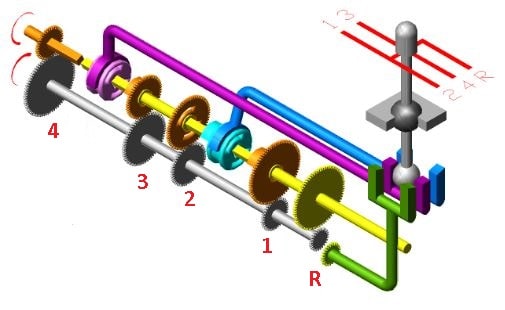
N – Neutral Gear
In neutral gear, the vehicle remains stationary and there is no coupling attachment in the transmission which means no power is transmitted.
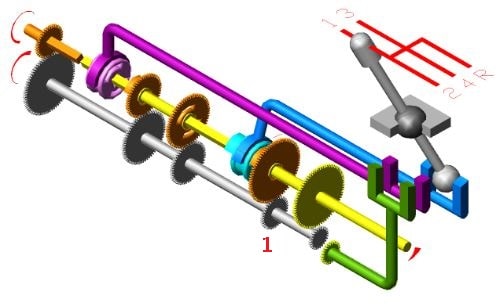
First Gear
A small gear is locked with the layshaft. Rotation is transmitted to the main shaft by a single gear of the input shaft and to the layshaft through a gear of either the first or two gear.
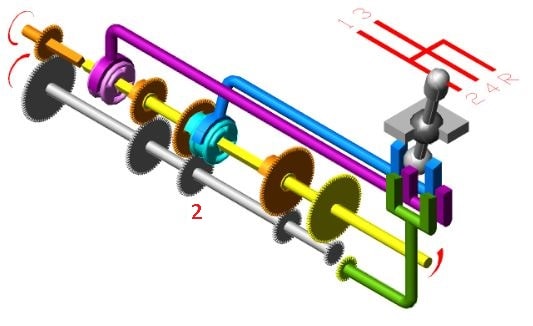
Second Gear
First gear speed is already allowing the car to accelerate, and it makes for a smoother shift to second gear.
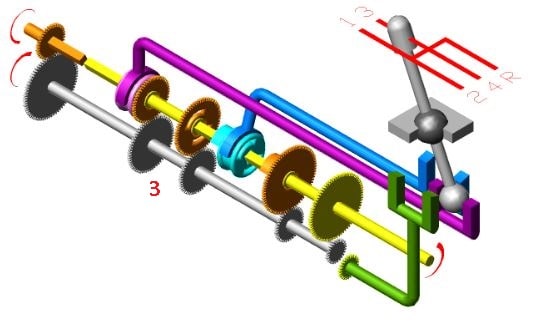
Third Gear
In the third gear, the forward speed increases more but the torque is reduced.
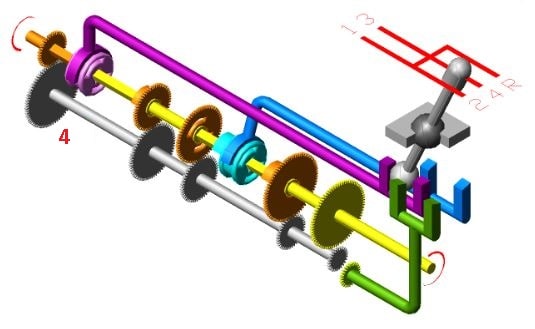
Fourth Gear
The fourth gear is direct drive. This means that the input shaft and main shaft are locked together to give a high amount of power to the engine.
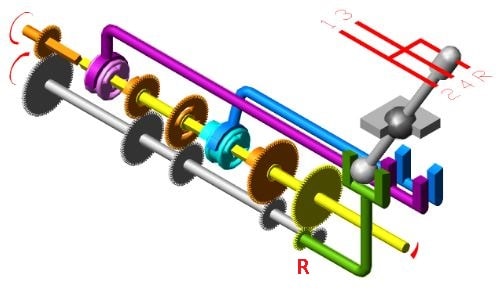
Reverse Gear
An idler gear is placed between the gears on the two shafts, causing the mainshaft to reverse direction.
Construction of Manual Transmission
If you’ve driven a car with a manual transmission, you know about the clutch pedal and gear shifter. The driver operates a manual transmission by using these two inputs.
In this system, the gearbox consists of three main shafts with continuously meshing gears of different sizes. The input shaft is connected to the engine by means of a clutch and the countershaft continuously meshes with the input shaft and consists of several gears.
Whereas the output shaft connects the countershaft to the driveshaft and probably to the wheels. In vehicles such as FWD and AWD, the output shaft is connected to the first transfer case and the reverse is usually on the fourth shaft to effect a change in direction.
You might like: How Does A Fuel Injection System Work?
Parts of Manual Transmission
Following are the parts of manual transmission:
- Transmission or Transfer case
- Input shaft
- Output shaft
- Layshaft
- Synchronizers
- Gears
- Stick shift
- Shift fork
- Bearing
- Extension Housing
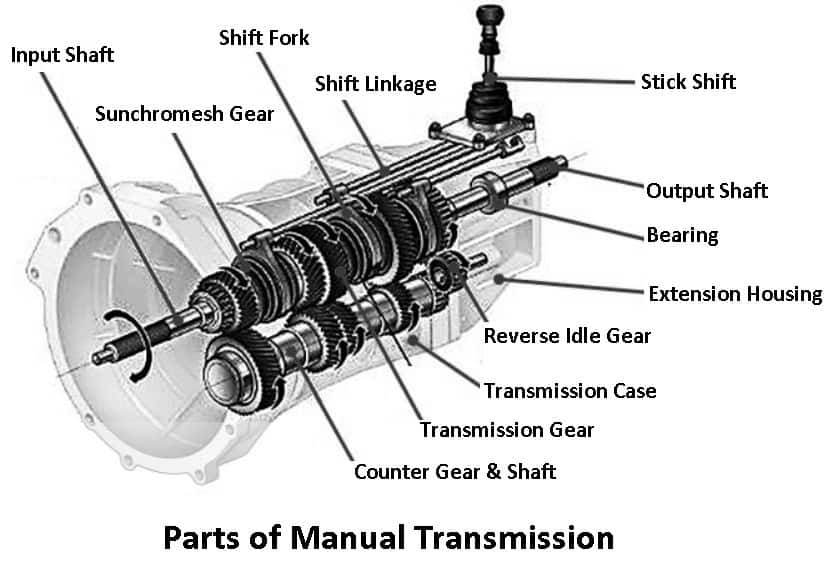
#1 Transmission or Transfer Case
It is part of the drivetrain that is used to transfer power from the transmission to the rear axles by using a drive shaft.
#2 Input Shaft
The input shaft of the transmission is connected to the layshaft, having gears on both shafts. Whenever the input shaft turns, the countershaft also rotates and is always in a fixed speed ratio.
#3 Output Shaft
The function of the output shaft is to send the power out of the transmission system to the engine. The output shaft gears are in mesh with the countershaft gear and rotate independently. It will rotate according to the power transferred by the layshaft gear.
#4 Countershaft
This is also known as countershaft. It rotates in the opposite direction to the input shaft. They spin whenever the engine is running and the clutch is engaged. Whenever a gear is selected by the driver they drive gear on the mainshaft.
#5 Synchronizers
Synchronizers facilitate engagement between the collar and gear to synchronize their motion. Plus, they help to adjust the shaft speed so that the gears align faster as you shift. Sometimes the speed can vary, so the synchronizer helps to avoid that happening.
#6 Gears
Basically, the manual transmission has three shafts with gears of different sizes. There are some large gears that have lots of teeth and some small gears which have few teeth.
The large gears generate extra torque, which helps in slowing the vehicle. Whereas smaller gears generate less torque, which helps the vehicle to travel at high speed.
#7 Stick Shift
It is located on the center console, the shift lever is connected to the transmission by a linkage and you can control it with your hand. With the shift lever, you can control and switch gears with ease. The function of the stick shift is to change gears manually as they accelerate and slow down a vehicle.
#8 Shift Fork
The selector fork is a type of gear that looks like a mechanical arm. The gear selector forks slide along the manual transmission’s layshaft. This permits the collars to move on the output shaft.
#9 Bearings
In a transmission system, the gears are in rotation and interlock to each other at all times with help of bearings. They also allow the input shaft and output shaft to rotate at different speeds.
#10 Extension Housing
The transmission has an extension housing that protects the output shaft at the rear of the transmission and also supports the bearings.
Read Also: How many types of engines are there?
How Manual Transmission Works?
In a manual transmission, the driver has to select the appropriate gear by engaging or disengaging the clutch. As we said, It works on the principle of gear ratio. When a larger gear coincides with and drives a smaller gear, the smaller gear will spin faster than the larger gear.
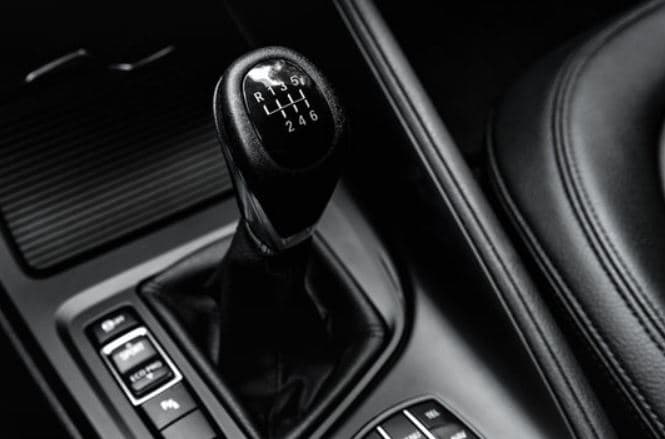
The larger the difference in gear size, the higher the gear ratio. In this, gears are mounted on shafts that rotate other gears. The gear shift selector drives the selection of gears, while the constant-mesh hypothetical connector and synchronizing ring ensure smooth working.
Starting with the first gear allows the engine to run at the optimum RPM to take the car from a steady state to a moving state. Once the car reaches the maximum optimum RPM range, the second gear is engaged.
Thus, the driver increases the speed and changes the gears until the desired speed is achieved. Maintaining the RPM range allows the engine to operate efficiently. The reverse turn is achieved by a three gear system and the synchronizer is kept idle.
This means that the transmission shaft must stop rotating before shifting to reverse gear. To stop the rotation of the transmission shaft without stopping the engine rotation requires disconnecting the clutch.
What is the H Pattern in Transmission?
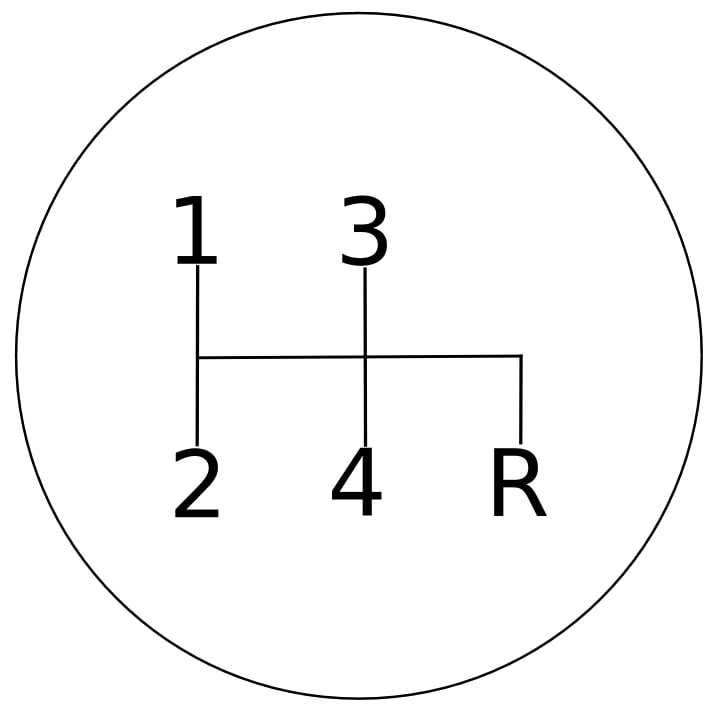
The H pattern is nothing but a design pattern of gears in a manual gearbox lever. In a car with a manual transmission, it allows the driver to move the shift lever back and forth to change gears according to the H pattern.
The top-left position of the shift lever indicates the first gear and the second gear is right straight down to it. To move to third gear, you need to shift up again to the right and up. Eventually, the fourth gear is in straight down to the third gear.
Read Also: What is the function of a flywheel in a car?
Types of Manual Transmission
Following are the types of manual transmission:
- Sliding mesh transmission
- Constant mesh transmission
- Dual-clutch transmission
- Automatic transmission
- Preselector transmission
#1 Sliding Mesh transmission
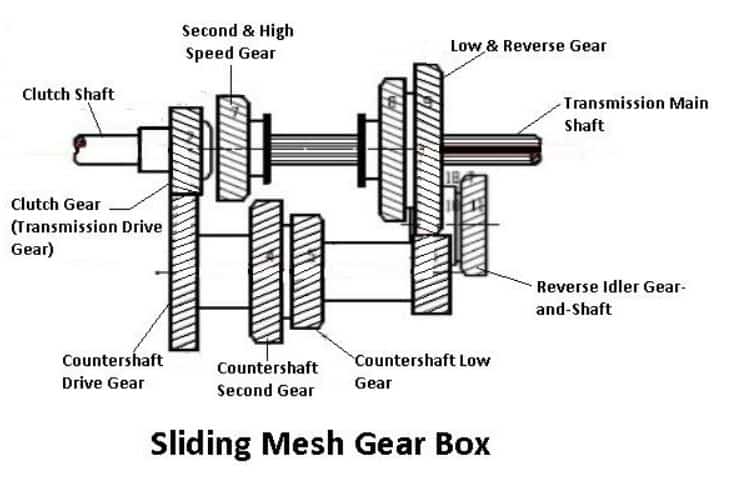
These transmissions are commonly seen in the old types of vehicles. When the transmission is in a neutral state, the only things that move are the main drive gear and cluster gear. To send power to the drive wheels, the clutch pedal must be pushed.
Moving the gear shift lever changes the position of the shift linkage and forks. It slides the gear along the main shaft directly over the cluster gear. Once these gears are engaged, the clutch is released. If you want to change gears again, you must disconnect the existing gear before shifting the new gears.
The sliding mesh transmission can provide relatively high efficiency compared to sliding mesh transmission because only one gear is in mesh, unlike the constant mesh transmission in which all gears are in mesh. Its design is simple which is one of its advantages.
#2 Constant-Mesh Transmission
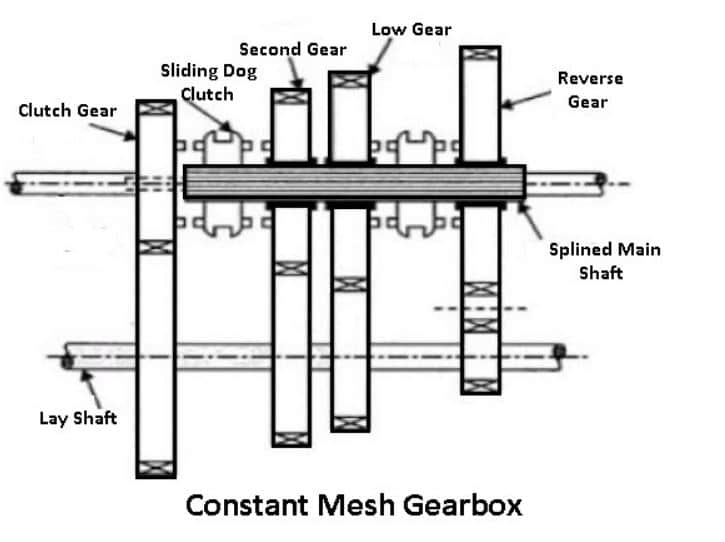
The continuous-mesh transmission maintains the motion of the gears, cluster gears, and main shaft gears as they are free to rotate around the main shaft. It has a dog clutch to lock these gears when required.
When the shift linkage moves, the teeth on the clutch and the main shaft gear lock onto each other and keep the gear stable. Synchronizers are used to prevent any collisions or grinding during transfer.
It uses helical gears to avoid vibrations and noises. They are highly beneficial due to their quiet operating capabilities. Since it uses two dog clutches, different gear ratios can be obtained.
#3 Dual-Clutch Transmission
A dual-clutch transmission is a modified version of a manual transmission with two sets of gears, each operated by a separate clutch. Basically, it uses two clutches which can be either wet or dry.
One clutch operates the even number of gears (2, 4, 6) while the other clutch operates the odd number of gears (1, 3, 5, and reverse gear). These types are very popular in older cars but are still found in modern race cars. DCTs offer better fuel economy than AMTs.
#4 Automatic Transmission
The automatic transmission (also known as AMT) is a manual transmission with a computer that controls the gear shifting and other major parts. Typically, it does not require any driver input to change gears under normal driving conditions.
Since it has axles and differentials in one combined assembly, thus it becomes a transaxle. It provides less effort for the driver and more features available to handle the car. Automatic transmission is commonly found in trucks.
#5 Preselector Transmisison
These are older models that were used in the 1930s. A preselector has a vacuum or hydraulic shift control and a planetary gear system to pre-select the gear ratio using a lever on the steering column.
The driver presses a foot pedal to shift gears that contact one of the gears already selected. As this happens, the rear gear stops while the new gear is engaged.
Read Also: What are the interior parts of the car?
Maintenance of Manual Transmission
A manual gearbox is easier to use and maintain than an automatic gearbox, and it can travel hundreds of thousands of miles before needing repair. In fact, all a manual gearbox requires is the periodic gear oil change, which is typically required every 30,000 to 60,000 miles, depending on driving habits and environmental factors.
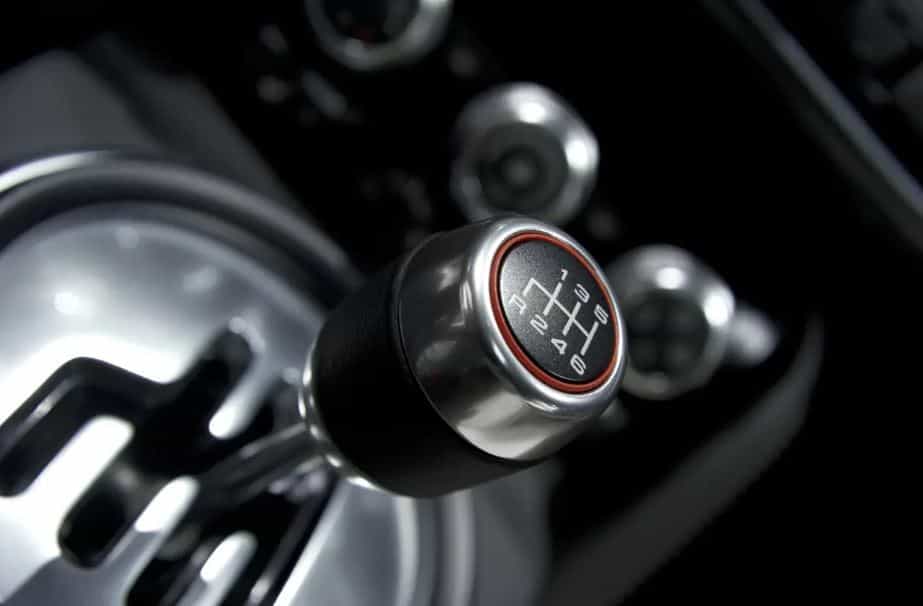
You may need to change the gear oil in your manual gearbox as frequently as every 15,000 miles if you drive a work truck, a race car or you simply drive aggressively. The gear oil doesn’t degrade in manual transmissions because of the lower temperature, but it does accumulate debris from the gears, bearings, and synchronizes.
Since manual transmissions lack filters, some of those particles merely float around, where they can cause wear by becoming stuck in other places.
The best way to extend the lifespan of your clutch and manual gearbox is to drive properly. Don’t ride the clutch unless you’re going downhill. As you press your foot on the clutch, the clutch releases your fingers, and the throwout bearing wears out. The clutch should be fully engaged when slowing down and released to downshift.
Riding the clutch only causes it to heat up and become worn out. Learn how to rev-match while downshifting to extend the lifespan of your clutch even further. It takes some getting used to, but by slightly increasing engine speed while engaging the clutch in the lower gear, the entire powertrain experiences less shift shock, and everything from the clutch to the driveline will last longer.
Advantages of Manual Transmission
- With fewer moving parts, a manual transmission can easily fit into your budget which means less expensive to purchase.
- These are easier to maintain because they are less complicated than automatics and less likely to go wrong.
- You can shift your car into neutral when you go down a hill. That means less power goes to the engine, and less fuel will burn. So better gas mileage can be achieved.
- Since manual transmissions have fewer moving parts, repair costs are significantly lower.
- By using engine oil, it wears out less quickly and doesn’t need to be changed frequently.
- If you have a vehicle with a manual transmission, you’ll get into fourth or fifth gear as quickly as possible and drive at higher speeds.
Disadvantages of Manual Transmission
- Manual transmission is rarely available in the market due to the widespread use of automatic vehicles.
- Learning to drive a vehicle with a manual transmission can be a difficult or challenging task.
- When you drive a car with a manual transmission, the clutch is likely to wear out, requiring a high repair cost to replace it.
- Driving up on hills can be risky and difficult if not prepared.
- In heavy-traffic situations, frequent stopping or starting and changing gears manually can make driving difficult.
Wrap Up
In short, vehicles with manual transmissions are considerably cheaper and more involved. Choosing a transmission system is quite a tricky task. However, if performance and driving experience matter to you, a manual transmission can be a perfect choice.
So for now, I hope I’ve covered everything about “manual transmission“. If you still have any doubts or questions on this topic, you can contact us or ask in the comments. If you like this article then please share it with your friends.
Want free PDFs direct to your inbox? Then subscribe to our newsletter.
Download PDF of this article
More from our site:
- What is a wankel rotary engine and how does it works?
- What is the main difference between drum and disc brake?
- Types of Chassis and Frames explained with pictures.
External sources:
All images from Wikipedia.com [Under Creative Common Licenses]
Am hambly requesting for the PDF file please
The PDF file has been sent to your inbox.
Am realy happy for the note . You guys should keep up the good work.
Please send me the PDF.
I’m glad it was helpful for you. The PDF file has been sent to your inbox.
Great thanks to the author and the surponsor , I m learning CV very nice. Please never give up
Thanks for your feedback.
Send me the PDF notes about the Automotive Manual and Automatic Transmission
The PDF file has been sent to your inbox.
AM happy with that notes,I request for engine parts, and function also please
The PDF file has been sent to your inbox.
Please send me PDF of manual transmission engine car
The PDF file has been sent to your inbox.
Very very nice
Thank you.